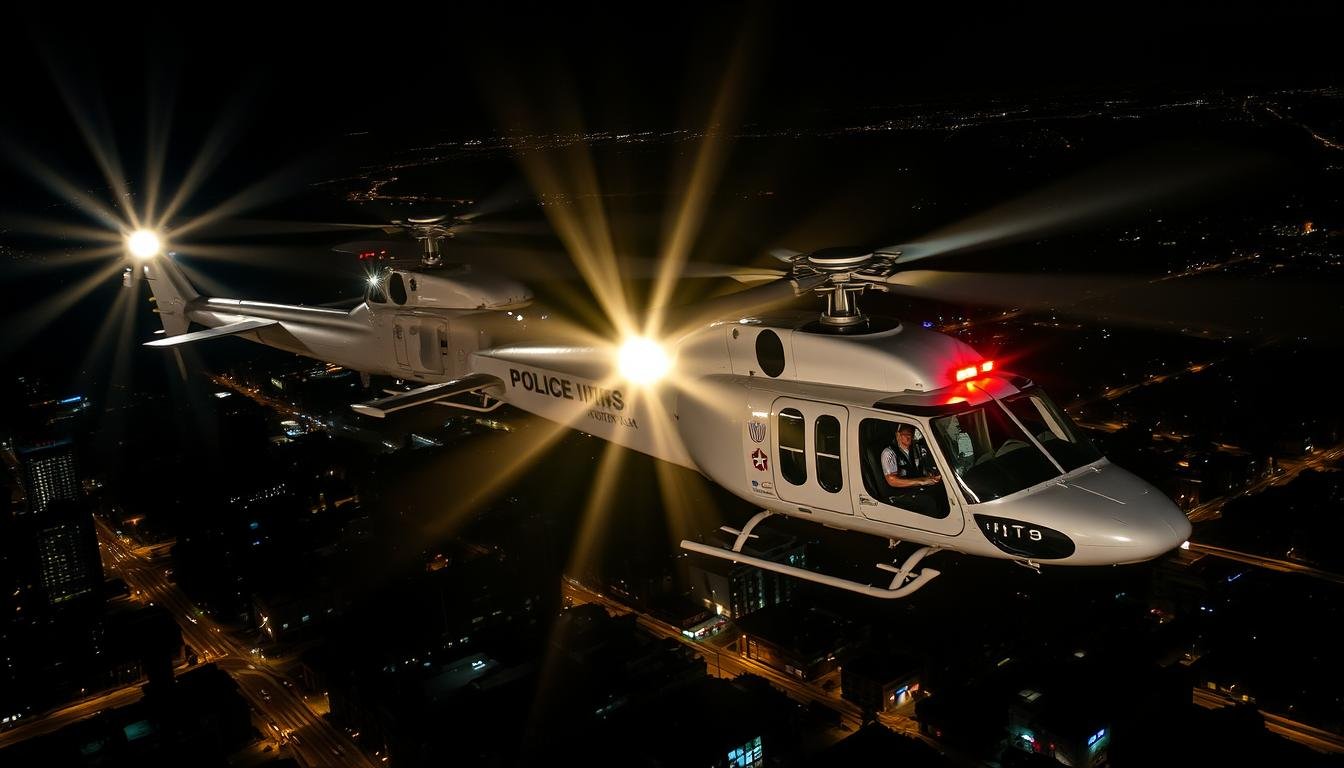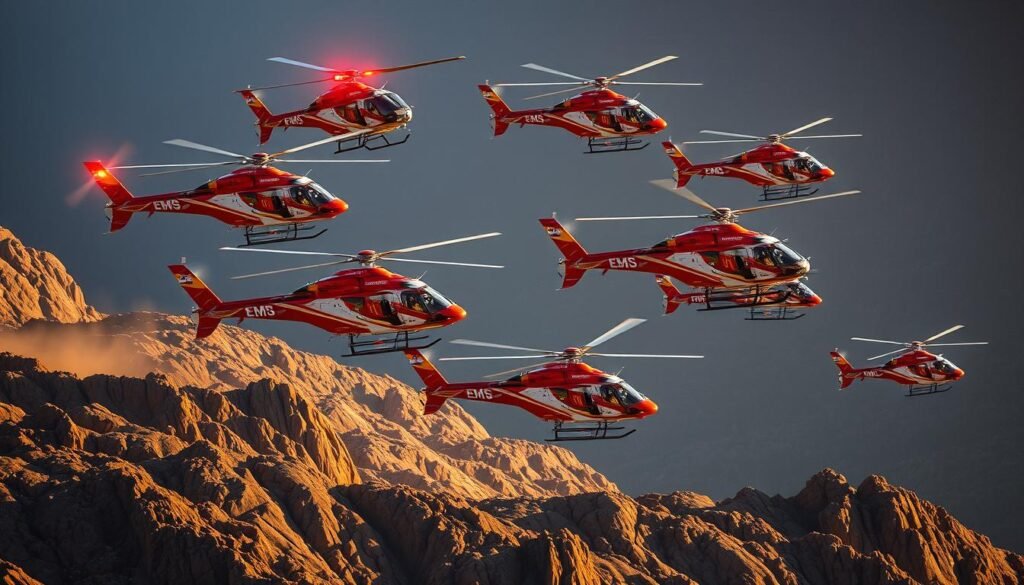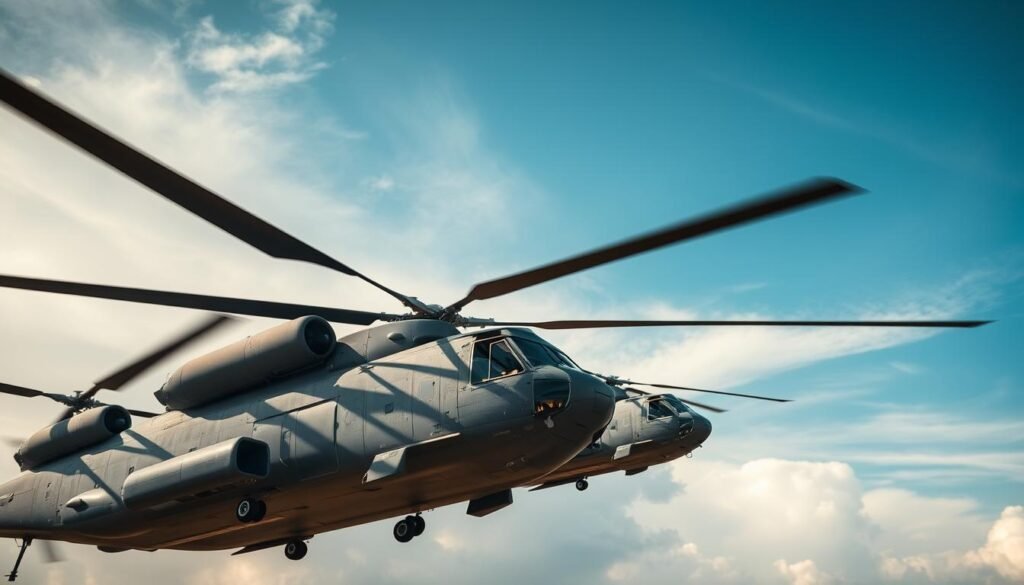Police helicopters give agencies the ability to cover miles in minutes, and studies show aerial units can reduce response times by up to 40% in critical incidents.
That reach changes outcomes: rotary-wing and fixed-wing aircraft provide rapid response, persistent observation, and aerial vantage points that ground units cannot match.
This introduction lays out what readers can expect: clear information on aircraft types, mission roles, sensor suites, and training standards that make air support effective and safe.
The piece also explains how aviation assets integrate with patrol and investigative teams to extend coverage, protect the community, and improve officer safety during pursuits and perimeter operations.
For those seeking deeper technical and operational details, a practical guide on platforms, sensors, and mission profiles is available at a related resource on aerial patrol capabilities: helicopter surveillance and patrol capabilities.
Key Takeaways
- Air support delivers rapid response and sustained observation over large areas.
- Different aircraft—rotary, fixed-wing, and lighter-than-air—serve distinct missions.
- Sensors like thermal cameras and NVGs increase effectiveness at night and in low visibility.
- Pilot training and recurrent certification are critical for safe, mission-ready operations.
- Agencies must balance operational benefits with noise, cost, and environmental concerns.
Police Helicopters In U.S. Law Enforcement Today
Air support delivers critical, real-time oversight that reshapes responses across urban and rural scenes.
Modern law enforcement relies on aerial assets to speed decisions and protect officers. Crews usually include a pilot and two tactical flight officers who interpret sensors and guide ground units.
Air Support’s Role In Real-Time Public Safety
Real-time overwatch helps teams track suspects, monitor crowds, and relay live video to command posts. Thermal imaging and searchlights are standard tools for nighttime searches and pursuits.
Support units provide continuous observation that reduces risk and improves containment strategies during complex incidents.
From Urban Centers To Remote Areas: Coverage And Response Times
Coverage models aim to minimize time to scene. For example, the national police service in the UK reports 98% of the population reached within 20 minutes, showing how regional aviation units enhance reach.
The Metropolitan force logs roughly 8,000 tasks a year, reflecting steady demand. In remote areas, air support bridges distance and terrain limits so responders arrive faster when minutes matter.
- Air units coordinate with patrol and investigative teams to deliver tactical value.
- Planning factors include aircraft availability, crew hours, weather, and night operations.
- Policy frameworks ensure deconfliction and prioritized tasking across neighboring agencies.
Police Helicopters
Aviation roles focus on rapid observation, pursuit management, and public order oversight. Crews usually include a pilot and two tactical officers who operate sensors and coordinate with ground teams.
Core Missions: Aerial Surveillance, Pursuits, And Public Order
- Aerial surveillance detects movement, locates suspects, and records evidence for enforcement operations.
- During pursuits, a police helicopter tracks vehicles from above so lead cars can back off and reduce collision risk.
- Large-event oversight uses persistent observation to monitor crowds and support safe public order strategies.

Search And Rescue And Emergency Medical Evacuations
Search tasks use thermal cameras and night vision to find missing people in low-visibility terrain. Rapid tasking lets crews cover hard-to-reach ground and water-edge areas fast.
Medical evacuations shorten transport time for critical patients when roads are congested or terrain limits access. Read more about how air rescue evolved how helicopters revolutionized emergency and rescue.
Ground Support And Interagency Coordination
Air support integrates with patrol to set perimeters, direct K9 teams, and hand off tracking to ground units. Standard operating procedures ensure deconfliction with other aviation traffic.
“Close coordination between air and ground units improves safety and evidence collection,”
Interagency cooperation expands reach and keeps operations consistent across neighboring jurisdictions.
Aircraft Types And Air Support Platforms
Airframe selection shapes how an aviation unit performs across diverse missions. Agencies balance endurance, noise, payload, and cost when choosing platforms. The result is usually a mixed fleet that matches mission profiles and community expectations.

Rotary-Wing Aircraft: Versatility In Operations
Rotary-wing aircraft deliver vertical lift, hover, and tight maneuvering. They enable landings in constrained spots and quick redeployment across urban or remote areas.
Modularity lets a single helicopter switch roles — from medevac to search to public order — by changing equipment and seating.
Fixed-Wing Aircraft: Long-Endurance, Quieter Surveillance
Fixed-wing types offer longer endurance and lower cost per hour for wide-area patrols. They are quieter at altitude, making them suitable for border and rural aerial surveillance and extended missions.
Lighter-Than-Air Platforms: Event Observation And Cost Efficiency
Blimps and tethered aerostats provide persistent coverage at low operating cost. They have proven useful at major events where continuous observation is needed without many crewed sorties.
Unmanned Aerial Vehicles: Expanding Aviation Units
UAVs extend reach into areas unsafe or impractical for crewed flights. They scale rapidly and pair well with manned assets to give commanders layered situational awareness.
- Equipment Integration: EO/IR cameras, downlinks, and mapping tools are standard across platforms.
- Fleet Strategy: Agencies mix surplus military frames and modern civil models to balance capability and maintenance.
- Community Impact: Noise and flight profiles influence platform choice, especially in dense urban areas.
| Platform | Strengths | Best Use Cases |
|---|---|---|
| Rotary-Wing | Hover, vertical lift, modular roles | Urban response, medevac, SAR |
| Fixed-Wing | Long endurance, quieter at altitude, lower hourly cost | Border patrol, rural surveillance, extended-area missions |
| Lighter-Than-Air | Persistent coverage, low operating cost | Large events, static observation posts |
| UAVs | Scalable, low-risk to crew, rapid deployment | High-risk sites, close-in searches, tactical supplement |
“Urban noise concerns shape flight routes and equipment choices for metropolitan air units.”
Sensors, Systems, And Mission Equipment
Advanced sensors and mission consoles transform airborne platforms into precision information hubs. The right fit of equipment and training lets crews find targets faster, guide ground teams, and preserve evidence for prosecutions.

Thermal Imaging, Searchlights, And NVGs
Thermal imaging systems detect heat signatures through smoke, foliage, and darkness. That capability accelerates target acquisition and search outcomes in low-light conditions.
High-intensity searchlights and night vision goggles extend operational windows. They improve navigation, scene illumination, and safety during complex approaches.
ANPR And Resilient Communications
Automatic number plate recognition (ANPR) integrated with mapping and records checks flags vehicles linked to crimes. A police helicopter equipped with ANPR boosts interdiction and investigative leads.
Digital downlinks and hardened data links deliver live information to command posts and patrol cars. Stabilized EO/IR gimbals provide evidentiary-quality video while onboard recording preserves chain of custody.
- Mission consoles with multi-sensor overlays let tactical officers cue cameras and annotate points of interest.
- Interoperable radios and data links support multi-agency operations and special task forces.
- Maintenance programs and redundancy reduce single-point failures and increase mission readiness.
For technical integrations and unit procurement, agencies review vendor systems like law‑enforcement avionics solutions and modern emergency response tech to match equipment to platform and mission.
How Air And Ground Units Work Together During Operations
Top-down visibility paired with disciplined radio calls reduces risk during dynamic scenes. Coordination and deconfliction let crews use air assets without disrupting street tactics. Commanders follow written procedures so everyone shares the same plan.

Pursuit Management And Scene Containment
An air support unit tracks movement from altitude so pursuit cars can ease back and maintain safer spacing. That reduces collisions and lets officers focus on tactical stops while the aerial view watches suspects.
Top-down observation also reveals gaps in perimeters and shows evasive routes. Ground supervisors use those feeds to close lanes and direct units precisely.
Large-Scale Events, Crowd Monitoring, And Evidence Gathering
Aerial support gives crowd flow assessments and highlights bottlenecks in real time. Stabilized video and still photography create a clear record for after-action reviews and court.
Transport And Logistics Support For Specialized Units
Support unit crews insert specialized teams and deliver gear where roads are blocked. Clear comms and prebriefed landing zones keep pilots, officers, and ground teams operating safely together.
“Post-incident debriefs that include air observations improve future coordination and outcomes.”
Pilot Qualifications, Training, And Unit Staffing
Flight crews meet strict standards that combine formal certificates with mission-specific training. The path blends classroom knowledge, logged time, and recurrent evaluations to produce reliable aircrew members.
Licenses And Ratings
Candidates progress from a Private Pilot License to an Instrument Rating and then a Commercial Helicopter certificate. Many pilots work as a Certified Flight Instructor to build experience before applying to a police aviation unit.
Flight-Hour Benchmarks And Medicals
Agencies set minimum PIC hours that vary by size and mission. Competitive candidates show significant night and single-pilot experience. An FAA Class II Medical is common; some roles ask for Class I to cover demanding schedules.
Police Aviation Training
Training emphasizes surveillance tradecraft, NVG operations, and emergency procedures. Crews rehearse confined-area approaches, inadvertent IMC recovery, and scenario‑based exercises with SWAT and investigative teams.
Crew Composition And Staffing
Typical crews pair a pilot with one or more tactical flight officers. Tactical officers operate sensors, manage comms, and handle mapping while the pilot focuses on aircraft control.
| Qualification | Purpose | Typical Benchmark |
|---|---|---|
| Private + Instrument | Basic airmanship and IMC proficiency | 50–100 hours |
| Commercial + CFI | Professional operations and hour building | 200–1,000 hours |
| FAA Medical | Fitness for duty and irregular schedules | Class II (common), Class I (preferred) |
| Unit Recurrent Checks | Maintain mission readiness | Annual check rides and scenario drills |
“Structured recurrent training and clear promotion tracks retain skilled pilots and strengthen unit depth.”
Safety, Risk Management, And Oversight
A culture of deliberate risk control underpins every aerial mission and shapes daily decision making. Leaders set clear go/no-go rules, track crew hours, and require frequent checks so teams stay proficient and rested.

Experience Requirements And Recurrent Checks
Agencies enforce rigorous experience thresholds. Pilots and tactical officers undergo recurrent evaluations every six months. Those checks validate skills, procedures, and sound judgment under stress.
Structured debriefs capture near-misses and lessons learned. Crash investigations then drive policy, training, and equipment updates.
Operational Risk: Weather, Workload, And Mission Profiles
Risk is tied to the mission environment, not the platform alone. UK CAA data shows a very low incidence of police helicopter accidents over a decade. Historical figures note a fatal helicopter rate near 9 per million hours (2003–2012), rising to 13.2 in 2013; such numbers reflect mission mix more than craft type.
- Recurrent checks every six months keep crews sharp.
- Decision tools assess weather, workload, and alternatives before launch.
- Hours tracking helps manage fatigue during night and multi-mission cycles.
- Coordination with dispatch and the support unit prevents single crews from becoming overtasked.
- Transparent oversight and shared data via aviation news and regulators build public trust.
“Clear go/no-go criteria empower crews to decline missions when conditions exceed safe operating envelopes,”
Cost, Value, And Community Impact
Comparing officer-hours to flight time reveals where air response delivers the greatest efficiency. Leaders weigh direct costs against measurable public safety gains and community expectations.
Operating Costs, Utilization, And Comparative Efficiency
Operating costs vary by aircraft type and mission, but evidence often favours aerial service for time-sensitive tasks. For example, a one‑square‑mile search that took 12 minutes by air cost about £160 versus 454 officer hours at roughly £4,500.
The metropolitan police handle near 8,000 tasks a year, showing sustained utilization that drives budgeting for aircraft and related support.
- Consolidation of national police air services aimed to cut UK overhead from £63m to £48m while keeping 98% coverage within 20 minutes.
- Historic hourly figures (about £1,600/hour in some forces) give leaders a baseline to compare alternatives.
Transparency, Noise, And Environmental Considerations
Community impacts shape deployment rules. Agencies publish aviation news and activity summaries so residents understand how an air support unit is used. Clear reporting builds trust.
Noise and emissions prompt route and altitude policies, and some forces evaluate quieter aircraft and new propulsive tech to reduce disruption during events and patrols.
| Metric | Example | Implication |
|---|---|---|
| Cost Per Hour | ~£1,600 (reported pre-consolidation) | Used to compare tactics and justify missions |
| Annual Budget | Metropolitan police ~£7m; North Wales ~£1.7m | Guides fleet size and hours available |
| Coverage | NPAS: 98% within 20 minutes | Balances cost with community reach |
“Value analysis should include reduced pursuit collisions, faster searches, and reassurance to the community.”
For readers assessing alternatives or leasing options, see a practical guide on the cost to rent a helicopter.
Conclusion
Airborne units continue to deliver decisive visibility that shortens response cycles and guides tactical choices. Police helicopters remain an essential asset for law enforcement, providing rapid aerial support, better crew coordination, and improved outcomes in searches and pursuits.
Safety culture is central: pilots and tactical officers follow strict recurrent checks, training, and oversight so missions balance benefit with risk. Lessons from crash reviews drive equipment and procedural upgrades.
Agencies also weigh community concerns about noise and emissions while refining flight profiles and investing in quieter tech. For historic pursuit data and program outcomes, see the pursuit outcomes study, which helps inform continued, transparent use of air support.
FAQ
What roles do aerial units play in U.S. law enforcement today?
Air support units provide real-time public safety assistance by conducting aerial surveillance, tracking moving subjects during pursuits, supporting search and rescue, and offering scene oversight for large events. They extend coverage beyond ground teams, improving situational awareness and shortening response times in both urban centers and remote areas.
What are the core missions of these aviation units?
Core missions include aerial surveillance, suspect pursuit support, public order monitoring, search and rescue, and emergency medical evacuation. They also assist ground teams with evidence gathering and provide logistical transport for specialized response units during major incidents.
Which aircraft types are commonly used for these missions?
Common platforms include rotary-wing craft for close-response versatility, fixed-wing planes for long-endurance, quieter surveillance over wide areas, lighter-than-air platforms for event observation and cost efficiency, and unmanned aerial systems that expand operational reach and lower risk to crew.
What sensors and systems equip modern air support platforms?
Typical mission equipment includes thermal imaging cameras, searchlights, night vision devices, automatic plate recognition, and robust communications links to maintain constant data and voice flow with ground units and command centers.
How do air and ground units coordinate during pursuits and scene containment?
Aerial crews provide a stable vantage point to track movement and relay location and intent to ground officers. That guidance helps ground teams select containment routes, manage risk for bystanders, and execute safe apprehension tactics while minimizing vehicle chases.
What qualifications and training do pilots and crew need?
Crew members must hold appropriate pilot licenses and ratings, meet FAA medical standards, and reach flight-hour benchmarks. Specialized training covers surveillance techniques, night-vision operations, emergency procedures, and tactical coordination with ground teams.
How do agencies manage safety and operational risk for aviation missions?
Units require recurrent checks, strict experience minimums, and documented risk assessments that account for weather, crew workload, and mission profile. Oversight includes routine maintenance, safety audits, and adherence to aviation regulations to reduce accident risk.
What are the main cost and community impact considerations?
Operating costs depend on airframe type, mission hours, and maintenance. Agencies weigh utilization against community benefits like faster response and enhanced public safety. Transparency, noise mitigation, and environmental impact are addressed through policy, flight routing, and community outreach.
How are unmanned systems changing aviation unit operations?
Unmanned aerial systems add persistence and lower-risk options for surveillance, evidence capture, and perimeter monitoring. They augment manned platforms, allowing crews to prioritize missions that require onboard sensors or crewed decision-making.
How do agencies measure value and efficiency of air support services?
Value is measured by mission outcomes, reduced response times, successful search and rescue results, and decreased ground pursuit incidents. Agencies track utilization rates, cost per flight hour, and operational metrics to assess comparative efficiency and justify resource allocation.y expand, offering even greater capabilities in crime prevention, public safety, and emergency management. For now, they remain one of the most effective tools in the law enforcement arsenal, keeping cities and communities safer from above.
Related Articles
- Medical Transport Helicopters: Critical Features and Models for Emergency Flights
- Helicopter Drones: The Future of Unmanned Aerial Systems
- Helicopters for Offshore Oil and Gas Operations: Transporting Workers and Equipment
- Helicopters in Tourism: The Best Models for Scenic Tours
- Helicopters for Police and Law Enforcement: Surveillance and Patrol Capabilities
More from This Category
- The Evolution of Attack Helicopters: Key Models and Their Capabilities
- Utility Helicopters: The Workhorses of the Sky
- Trainer Helicopters: The Best Models for Learning to Fly
- Helicopters for Aerial Photography and Filmmaking: Top Picks for Capturing the Perfect Shot
- Luxury Helicopters: The Best Models for Private and Corporate Use
- Heavy Lift Helicopters: Moving Large Cargo and Equipment
- Agricultural Helicopters: Aerial Spraying and Crop Management
- Rescue and EMS Helicopters: How They Save Lives in Critical Situations
- Military Helicopters: Key Models and Their Combat Roles
- The Different Types of Helicopters: From Light Utility to Heavy Lift



